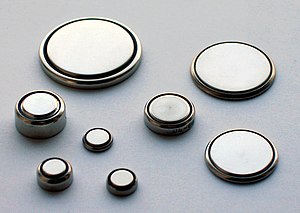This article needs additional citations for verification. (August 2023) |

A button cell, watch battery, or coin battery is a small battery made of a single electrochemical cell and shaped as a squat cylinder typically 5 to 25 mm (0.197 to 0.984 in) in diameter and 1 to 6 mm (0.039 to 0.236 in) high – resembling a button. Stainless steel usually forms the bottom body and positive terminal of the cell; insulated from it, the metallic top cap forms the negative terminal.

Button cells are used to power small portable electronics devices such as wrist watches and pocket calculators. Wider variants are usually called coin cells. Devices using button cells are usually designed around a cell giving a long service life, typically well over a year in continuous use in a wristwatch. Most button cells have low self-discharge, holding their charge for a long time if not used. Relatively high-power devices such as hearing aids may use a zinc–air battery, which has a much higher capacity for a given size, but dries out after a few weeks even if not used.[citation needed]
Button cells are usually disposable primary cells, but some are rechargeable secondary cells. Common anode materials are zinc or lithium. Common cathode materials are manganese dioxide, silver oxide, carbon monofluoride, cupric oxide or oxygen from the air.[citation needed] Mercuric oxide button cells were formerly common, but are no longer available due to the toxicity and environmental effects of mercury.
Button cells are dangerous for small children, as when swallowed they can cause severe internal burns and significant injury or death.[1] Duracell has attempted to mitigate this by adding a bitter coating to their batteries.[2]
- ^ "See what a button battery can do to a child's throat". BBC News Online. 22 September 2016. Archived from the original on 22 September 2016.
- ^ "Duracell Is Making Coin Batteries Taste Horrible on Purpose". PCMAG. Retrieved 2022-02-17.